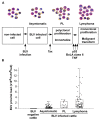Mechanisms of pathogenesis induced by bovine leukemia virus as a model for human T-cell leukemia virus
- PMID: 24265629
- PMCID: PMC3820957
- DOI: 10.3389/fmicb.2013.00328
Mechanisms of pathogenesis induced by bovine leukemia virus as a model for human T-cell leukemia virus
Abstract
Bovine leukemia virus (BLV) and human T-cell leukemia virus type 1 (HTLV-1) make up a unique retrovirus family. Both viruses induce chronic lymphoproliferative diseases with BLV affecting the B-cell lineage and HTLV-1 affecting the T-cell lineage. The pathologies of BLV- and HTLV-induced infections are notably similar, with an absence of chronic viraemia and a long latency period. These viruses encode at least two regulatory proteins, namely, Tax and Rex, in the pX region located between the env gene and the 3' long terminal repeat. The Tax protein is a key contributor to the oncogenic potential of the virus, and is also the key protein involved in viral replication. However, BLV infection is not sufficient for leukemogenesis, and additional events such as gene mutations must take place. In this review, we first summarize the similarities between the two viruses in terms of genomic organization, virology, and pathology. We then describe the current knowledge of the BLV model, which may also be relevant for the understanding of leukemogenesis caused by HTLV-1. In addition, we address our improved understanding of Tax functions through the newly identified BLV Tax mutants, which have a substitution between amino acids 240 and 265.
Keywords: B-cell lymphoma; BLV; EBL; HTLV-1; Tax; apoptosis; leukemogensis; transactivation.
Figures




References
-
- Aida Y. (2001). Influence of host genetic differences on leukemogenesis induced by bovine leukemia virus. AIDS Res. Hum. Retroviruses 17 S12
-
- Aida Y., Miyasaka M., Okada K., Onuma M., Kogure S., Suzuki M., et al. (1989). Further phenotypic characterization of target cells for bovine leukemia virus experimental infection in sheep. Am. J. Vet. Res. 50 1946–1951 - PubMed
-
- Aida Y., Okada K., Amanuma H. (1993). Phenotype and ontogeny of cells carrying a tumor-associated antigen that is expressed on bovine leukemia virus-induced lymphosarcoma. Cancer Res. 53 429–437 - PubMed
Publication types
LinkOut - more resources
Full Text Sources
Other Literature Sources

